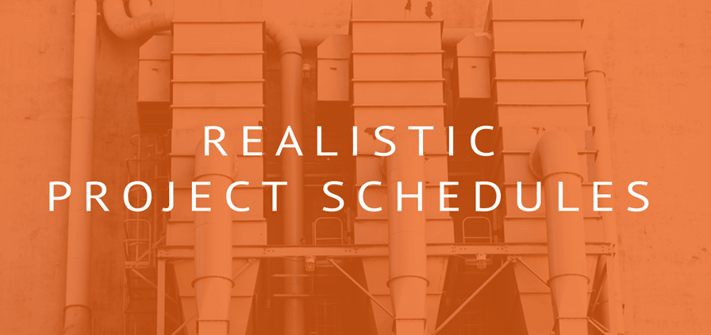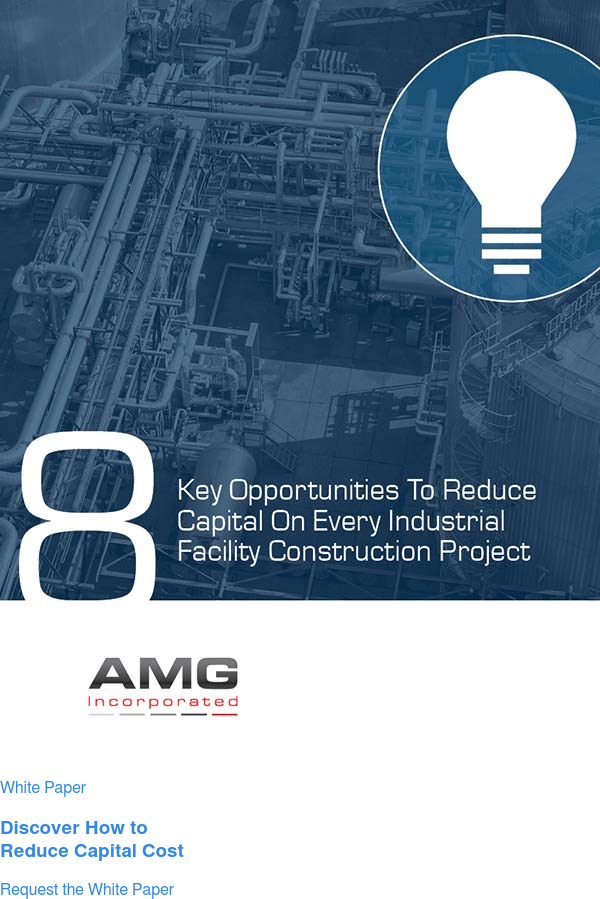
When it comes to the construction or expansion of a facility, the project schedule is a dynamic and complex deliverable—with lots on the line.
Early on, before work has been started, the project schedule:
- Aligns operations and construction around a shared schedule, so that each can properly plan for the complexities of the project.
- Establishes the milestone dates that progress & profitability will be benchmarked against during the life of the project.
- Sets expectations with project stakeholders and upper management long before the project is out of the starting gate.
Therefore, getting project schedules right, and getting them right early on, is crucial to overall project success.
Adding to the complexity, many project leaders build a complete project schedule from many different proposed schedules—from team members, consultants, vendors, and contractors. Often, the leader has little to no knowledge of the level of scheduling skill or industry experience of these other players.
For these reasons, project leaders should never take a project schedule at face value. It’s important that you perform a series of reality checks against the schedule to verify its validity before signing off it, and broadcast expectations to the entire team while chiseling the schedule into the minds of management.
Here are 7 questions you should ask of every proposed schedule.
Does the project schedule identify all pre-construction activities and allocate adequate time for each?
Verify the schedule includes time for activities such as geotechnical investigations, pre-engineering, permitting, and gated FEL studies.
If there are gated FEL requirements, be sure to verify what gates are required to obtain project funding and verify that funding for the preconstruction activities will be available when you need them.
Also, don’t assume that all project stakeholders know that an emissions control permit can take 6 months to obtain. In most states you are not allowed to install any permanent structure like foundations until the permit has been received which should be clearly noted in the schedule.
Are all scheduled tasks linked by predecessor and successor?
Projects are dynamic, meaning the schedule needs to be dynamic as well.
Best practice would be that all tasks (activities) in the schedule have at least one predecessor and one successor (with the exception of the project start and finish tasks). Linking all the tasks allows your schedule to be dynamic and automatically update when new information is received and input. Avoid linking tasks to summary tasks.
Many times a task will have several predecessors. A common example of this is structural steel erection. “Foundation installation” and “Steel Fabrication and Delivery” are two common predecessors to steel erection.
Are critical tasks scheduled in the most efficient sequence?
Task progression or task logic is one of the most critical aspects of a schedule and one of the most difficult and tedious to verify.
Most scheduling programs include a “Critical Path” view which narrows the focus to what tasks are defining the finish date. It is important to understand the true progression of EPC tasks to verify against the critical path view.
We’ve often encountered a flaw in the logic that, once fixed, changes the critical path tasks entirely. A good example of this is the scheduling of the design for the foundations and steel. At first glance it would seem that since the foundation gets installed first, the foundation design should be completed first. However, with lead time on steel detailing/fabrication being 10 to 16 weeks, it would be more efficient to design the steel first allowing foundation design, bid, and installation to be completed while you wait for the steel to be fabricated and delivered.
Is the amount of time allocated for each task in line with historic experience?
Review each task duration and see if it's in-line with past experiences.
Some facility systems, such as dryers or evaporators, may take 4-6 weeks to procure, and could take up to 20 weeks to fabricate. It’s important to know that going in. If you are not sure about a specific duration, ask someone that has prior experience with that type of task or with the type of project.
Discovering during the life of the project that an equipment’s lead time is 20 weeks instead of 8 weeks can wreak havoc on a schedule.
Understanding metrics such as tons of steel, lineal feet of pipe, or cubic yards of concrete installed per day can be helpful in back checking task durations. The three-point method of estimating is also a good way of validating durations if you have good data from previous projects.
Are the workflows and resources included in this schedule realistic?
We’ve all heard the logic that “if it takes someone 10 hours to complete an activity, then put 10 people on it and it’ll be done in an hour.” That’s why it’s important to look at resourcing through a few different views, such as:
- By Task Manpower: Look for reasonable manpower loading on individual tasks. Ask yourself, “Can this contractor reasonably provide X number of people for this duration”? Estimate man-hours and review peak loadings.
- By Trades Involved: Trade stacking is important to review. Ask, “Can X number of people reasonably work in the same area at the same time”? We’ve seen many projects where electricians and pipe fitters were battling for the same workspace day after day making both trades inefficient and more prone to look for change orders to cover the cost of the inefficiencies and added time.
- By Workforce Sourcing: Sometimes, the project’s location makes it hard to find qualified people. While not always an issue, the local workforce can play a part in determining the schedule. Knowing about local expansions that are causing a lean local workforce can be beneficial when developing a schedule that can be properly adjusted to utilize non-local contractors to fill production gaps.
Is contingency built in for delays—and are there recovery plans in place outside of the baseline schedule?
Sometimes, PMs tend to develop “best case” schedules instead of real ones; leading to high expectations early on, and setting up for over-promising and under-delivering when things don’t go as planned.
The schedule should build in a reasonable amount of contingency for weather delays, shut downs, holidays, potential traveling workforce, and general slips in deliveries.
Beyond baseline, a schedule should include backup plans for recovery if there is a risk the schedule is likely to deviate from the baseline. Increasing hours, working weekends, and additional shifts, are good ways to get the project back on track if trending behind.
Building these into the schedule baseline leaves little options for recovery.
What is “finished”—and what is driving the finish date?
Be aware that top management will remember the “finish date” the moment they see it.
When back checking a schedule, it is crucial to understand where the “finish by” date originated. Was the project deadline determined by a sales commitment, by management, by a best case scenario scratched out on a piece of notepad, or some other influence? Is the “finish date” the day you turn over the keys, or does it mean “mechanically complete” and ready for startup?
Knowing the criticality of the finish date is a vital piece of your reality check—and will be sure to set realistic expectations with management early on.
Better schedules deliver better results.
Project schedules are complex and dynamic deliverables—and no matter how well crafted, leadership will always want them to be shorter.
Project leaders should never take a schedule at face value. Taking the time to reality check the schedule before signing off on it will help you manage timing expectations early on with valid data, and can save you hours adjusting and defending it while your project is underway and under the microscope.
And most importantly, getting it right will set realistic expectations and benchmarks to determine project profitability—making you look like a rock star in front of management.


